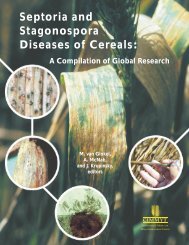Section 3 (Crop Management)
Section 3 (Crop Management)
Section 3 (Crop Management)
You also want an ePaper? Increase the reach of your titles
YUMPU automatically turns print PDFs into web optimized ePapers that Google loves.
Results and Discussion<br />
Tripathi<br />
Maize-based system<br />
In low fertile and marginal rainfed uplands of excessive rainfall area (Lumle ) even high dose of<br />
chemical fertilizers alone gave very poor yields of maize and fingermillet. Application of 120 kg N/ha<br />
through organic sources or combination of 60 kg N/ha through organic + 60:30:20 kg/ha through<br />
inorganic sources produced 1.71 ton maize grain/ha (Table 4). Organic sources alone or combination of<br />
organic and inorganic sources produced better yield of relayed fingermillet (0.57 – 0.69 t/ha) in maize<br />
than inorganic fertilizers alone (0.36 – 0.44 t/ha). In medium fertility condition application of 120:60:40:<br />
kg N: P2o5: K2o/ha or 60 kg N/ha through FYM could give more than 6t maize grain/ha.<br />
Synchronizing N requirement<br />
During 2000, maize grain yield differed significantly but finger millet grain yield did not differ<br />
significantly among treatments. Application of 5 ton FYM plus 60 kg N at planting or 30 kg N at planting<br />
and 30 kg N at knee high stage or 10 ton FYM plus 30 kg N at knee high and 30 kg N at silking or 60 kg at<br />
knee high stage produced significantly low yields as compared to other treatment (Table 5). The results<br />
showed that 5 ton FYM at planting plus 60 kg N/ha at earthing up or 10 ton FYM at planting plus 3 splits of<br />
N (20 kg at planting, 20 kg at knee high and 20 kg at silking) gave similar yields of maize grain (5.29 – 5.32<br />
t/ha).<br />
During 2001, out of 14 treatments 8 treatments gave more than 4.50t maize grain/ha. Maize grain yield in<br />
the treatments of 10t FYM+60kg N/ha as top dressing at silking stage gave only 3.39t/ha and all the other<br />
treatment gave significantly high yield irrespective of organic and inorganic sources as well as different<br />
application dates (Table 5).<br />
N, P, K limiting<br />
Maize yield data of 2000 at Deurali and Pakuwa representing mid and low hills respectively were not<br />
representative and excluded in this report. Significant response of 100 kg N, 100 kg N + 100 kg P, 100 kg N<br />
+ 100kg P + 100kg K /ha was not observed when compared with farmers’ practice (Table 6). However,<br />
above dose of NPK plus 5 ton lime/ha gave significantly high yield as compared to farmers’ practice and 100<br />
kg N/ha at both sites during 2000. Yield trends were similar in both locations during 2000. During 2001,<br />
treatment difference was not observed at Bhakimli site but farmers practice gave significantly low yield as<br />
compared to other treatments at Deurali and Chambas sites (Table 6).<br />
Selection of Acid Soil Tolerant Germplasms<br />
Acid soil V-yellow<br />
Out of 28 genotypes, 16 genotypes (57%) produced 5.83 to 7.99 ton grain/ha which were at par but were<br />
significantly higher yielder than rest of the 12 genotypes (Figure 1). These ten genotypes (CLA 43 X<br />
(LASP2 X LASP3), CLA 28 X CLA 29, CLA 9 X CLA 10, CLA 15 X CLA 30, CLA 12 X CLA 13,<br />
CLA 37 X CLA 35, CLA 37 X CLA 40, CLA 41 X (LASP2 X LASP3), CLA 34 X CLA 35 and CLA 44<br />
X (LASP2 X LASP3) are the top yielder and could tolerate acid soil condition.<br />
Acid soil Vi-yellow<br />
Out of 20 genotypes of maize, 11 genotypes (55%) which produced 4.67 to 6.97 ton grain/ha were at par<br />
but gave significantly higher yield as compared to rest of the genotypes including local check (Rampur<br />
composite) in the acidic soil of Chambas Tar (Figure 2). The ten genotypes Sikauni, Cimcali 97 B Achap 1A<br />
- 285 -









